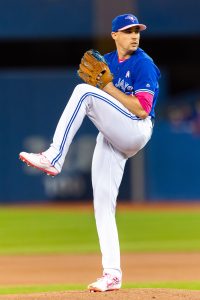Although the Marlins have the worst record in the National League and the fifth-fewest wins in all of baseball, the organization has “no intention” of trading left-hander Caleb Smith to further its rebuilding effort, tweets Joe Frisaro of MLB.com. More broadly, he notes that Miami isn’t looking to deal from its core of controllable starters.
It still seems quite likely that teams will at least ask about Smith, 27, in the weeks leading up to the July 31 trade deadline. He’s currently on the 10-day IL due to some inflammation in his hip, but there’s no indication to this point that the injury is especially serious. Smith is controllable for four years beyond the 2019 campaign, which would hold enormous value to another club, particularly given how well he’s thrown when healthy.
Through 66 innings this year, Smith has turned in a 3.41 ERA with 11.2 K/9 against 2.7 BB/9. He’s an extreme fly-ball pitcher who has been homer-prone even with a cavernous home park, but his 15.1 percent swinging-strike rate ranks fifth among pitchers with at least 60 innings thrown, trailing the quartet of Blake Snell, Max Scherzer, Justin Verlander and Gerrit Cole. Smith’s 35,4 percent opponents’ chase rate is tied for 12th-best in that same set of 114 pitchers, and the spin rate on his heater falls in the 80th percentile among MLB pitchers.
Of course, all of those reasons are also cause for Miami to hang onto Smith. The Marlins aren’t going anywhere in 2019 and aren’t likely to contend in 2020, either, but they can keep Smith on the roster via arbitration all the way through the 2023 campaign. And for as solid as Smith has been on a per-inning basis, he’s yet to throw more than 77 1/3 innings in a big league season. He reached that level in 2018 before a Grade 3 lat strain ended his season, and his innings in 2019 are expected to be limited as a result. Other clubs may even be more interested in Smith if he proves durable enough to handle a full season of starts (or close to it), and Miami will have ample opportunity to market him down the road if the concept of moving him becomes more palatable.
As for the rest of the Marlins’ rotation, the bulk of their arms are even longer-term pieces. Sandy Alcantara, Pablo Lopez and Trevor Richards are all controllable for five years beyond the current season, while fresh faces like Jordan Yamamoto and Zac Gallen can be controlled through at least 2025. Righty Jose Urena could very well have been attainable, but he’s now on the 60-day injured list due to a herniated disk in his back.
Frankly, the Marlins don’t seem to have many trade assets at all if the plan is indeed to hang onto their intriguing mix of young arms. Veteran Neil Walker has had a productive year and could be flipped for a modest return if he continues to perform once he’s recovered from the quad strain that currently has him on the IL. Fellow free-agent pickups Curtis Granderson and Sergio Romo haven’t been effective (particularly in the case of Granderson), and veteran Starlin Castro is having the worst offensive season of his career. It could be a quiet deadline for the Marlins unless they surprise by changing course with regard to their controllable starters and/or opt to pursue some bats with a good bit of team control remaining.
